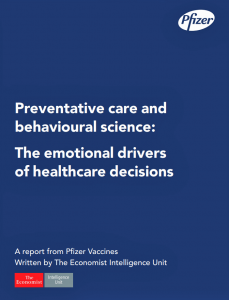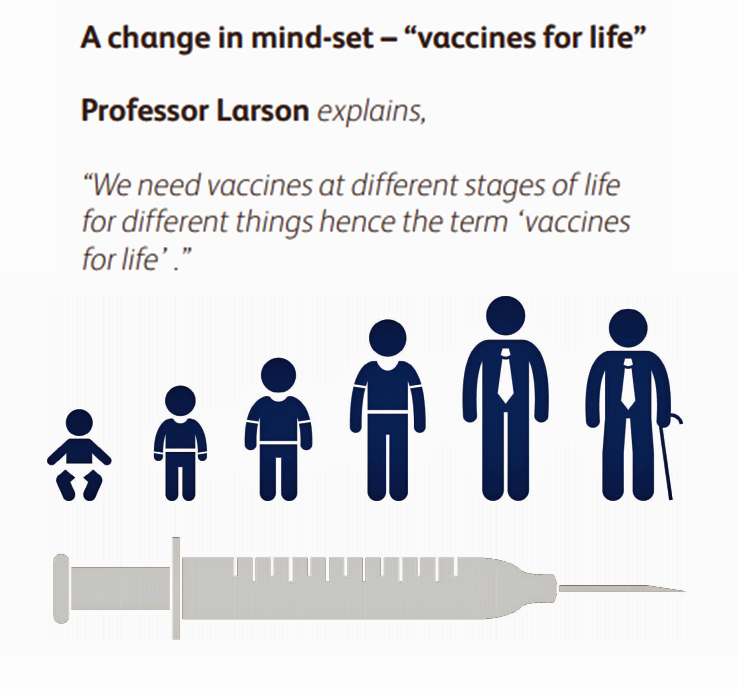
There are health facts that are based on rigorous scientific evidence. And, there are people who, for a variety of reasons, make irrational healthcare decisions without regard to those health facts.
An important new report discusses the all-too-human aspects of people-as-patients, who often make health decisions based more on emotions than on the cold, hard truths that could save their lives and protect the well-being of loved ones.
Preventative care and behavioural science: The emotional drivers of healthcare decisions is that report, sponsored by Pfizer Vaccines and written by the Economist Intelligence Unit (EIU).
The report analyzes the psychological factors that shape consumers’ health decisions, looking into emotional and cognitive issues that prevent people from fully engaging with and taking advantage of preventive care services.
(Eagle-eye readers will note the British spelling of “preventative” and “behavioural” in the report’s title; I will use the Americanized language in this blog [eg., “preventive”], citing the report title in its original form).
Prevention in this report is focused on vaccines, which is a loaded topic on both sides of the Atlantic Ocean in various circles. One of the main sources that vaccine-detractors have cited in the recent past was written by Dr. Andrew Wakefield et al., and published in the UK’s prestigious medical journal, The Lancet, in 1998. The article was subsequently retracted, critiqued on the basis of faulty methodology, conclusions and recommendations.
 Still, there are (too) many people who reject vaccinating their children, as well as older adults who dismiss the value of vaccines for prevention. These individual choices put herd immunity at-risk for the Commons — that is, for the vast majority of health citizens who opt-in to the public and personal health benefits of vaccination.
Still, there are (too) many people who reject vaccinating their children, as well as older adults who dismiss the value of vaccines for prevention. These individual choices put herd immunity at-risk for the Commons — that is, for the vast majority of health citizens who opt-in to the public and personal health benefits of vaccination.
When it comes to prevention in this case, it does take a village.
The benefits of vaccines have been time-tested and proven. Vaccination has been a cost-effective way of dramatically reducing the burden of infectious disease globally.
Several factors increase a person’s likelihood of opting-in to preventive care: higher socioeconomic status ties to greater use of preventive services, as does age which positively correlates to more prevention. The report notes that some studies have shown women have greater adoption rates of prevention than men in the same income and age cohorts.
So what’s getting in peoples’ way in saying “yes” to a proven preventive health action?
The report discusses cognitive biases that may prevent people from adopting prevention, such as facing too many choices (resulting in a sort of analysis paralysis) or not dealing well with uncertainty. Both cases can result in a consumer not taking on preventive care.
Another cognitive scenario is what the authors coin as the “nocebo effect.” You know the “placebo effect,” which happens when positive expectations improve an outcome. The nocebo effect is just the opposite: when a person’s negative expectations of a treatment cause a more negative effect than it otherwise would have on the person. If the consumer has seen information that’s negative about a treatment, “this exposure can lead to self-fulfilling prophecies of experiencing the same negative side effects,” the report explains.
 The report notes that the nocebo effect can result from peoples’ exposure to too much information. The authors cite a study published in The Lancet in 2017 that found that 20% of the users of statins (to lower the risk of heart disease) cited negative side effects such as muscle pain compared with those who were taking a placebo, unsure they were ingesting a statin. “When they had no idea,” the researchers found, “there was no increase in muscle-related effects.”
The report notes that the nocebo effect can result from peoples’ exposure to too much information. The authors cite a study published in The Lancet in 2017 that found that 20% of the users of statins (to lower the risk of heart disease) cited negative side effects such as muscle pain compared with those who were taking a placebo, unsure they were ingesting a statin. “When they had no idea,” the researchers found, “there was no increase in muscle-related effects.”
How to deal with these challenges? The report offers several recommendations:
- Balance data and anecdote when making the case for preventive care
- Take into account the range of sources people use for healthcare information — physicians, patient advocates, peers, and online sources
- Use appropriate spokespeople relevant to the target patient group for messaging
- Appreciate and account for the role played by emotions — fear, happiness, risk-aversion — to motivate action for the preventive measure
- Personalize the approach when advising patients; be respectful and empathetic
- Employ shared decision making principles with patients.
Ultimately, for vaccinations, we must build “vaccine confidence,” the report concludes. That’s the belief that vaccination serves the best health interests of the public and the people who comprise that public.
The third graphic featuring the person’s life cycle is a positive paradigm to consider here: as Professor Larson of the Vaccine Confidence Project at the London School of Hygiene and Tropical Medicine asserted, “We need vaccines at different stages of life for different things; hence the term, ‘vaccines for life.'”
With the advent of new-new vaccines that help older people to prevent shingles, for example, this life-cycle approach is worth sharing with our loved ones, neighbors, colleagues, and clinicians. 
Health Populi’s Hot Points: The fourth exhibit titled, “Encourage peer-to-peer support,” discusses the viral nature (pun intended) of our social networks and peer-to-peer healthcare. As my friend and wise colleague Susannah Fox has described this phenomenon, based on her research, “your community may be your superpower.”
The snippet here from the report talks about HIV prevention in the Ukraine, leveraging the peer support model to stem the rising prevalence of HIV in the nation. The WHO and other NGOs worked with the region on a multi-layered strategy, which included a peer-to-peer counseling component. This involved training a group of patients and consumers at-risk of contracting HIV, and convening counseling sessions. These folks, then, recruited other peers to be trained, convening more meet-ups, and so on.
Over time, HIV cases dropped by a factor of four in the Ukraine.
Indeed, prevention takes a village, comprised of people who care about one another. That’s the village I want to live and Make Health in.





 I was invited to be a Judge for the upcoming
I was invited to be a Judge for the upcoming  Thank you Team Roche for inviting me to brainstorm patients as health citizens, consumers, payers, and voters
Thank you Team Roche for inviting me to brainstorm patients as health citizens, consumers, payers, and voters  For the past 15 years,
For the past 15 years,